Lepcis Magna, Byzantine Church
Lepcis Magna: Phoenician colony, later part of the Carthaginian empire, the kingdom of Massinissa, and the Roman empire. Its most famous son was the emperor Septimius Severus (r.193-211).
Byzantine Church
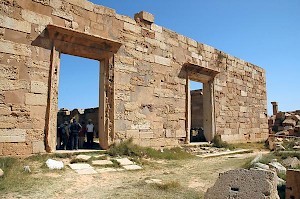
As was common in the fourth century, the inhabitants of Lepcis Magna converted to Christianity. They were not the first adherents of the new faith: a bishop is mentioned in 258. The first churches have not been identified, nor do we know much about the opinions of the believers, who may have adhered to the Nicene Creed, or may have been Donatists, or both.
In 455, the Vandals conquered Lepcis; they were Arian Christians, and there may have been tensions. Almost eighty years later, in 533/534, the armies of the Byzantine emperor Justinian, commanded by Belisarius, took Lepcis from the Vandals, and propagated a Christianity that was based on the Nicene Creed.
In his book on Justinian's Buildings, Procopius says that the emperor "dedicated to the Mother of God a very notable shrine, and built four other churches".note The main church is identical to the Severan Basilica; among the quartet was the church shown on the photos on this page. It was constructed in an old house at the beginning of the Colonnaded Street, between the Nymphaeum and the Severan Forum.
Like so many sixth-century churches, this sanctuary had the form of a basilica with three naves, which were separated by two lines of columns with Ionic capitals; the columns were made of cipollino marble from Euboea and were probably removed from a collapsed temple. The little stairs in front of this photo are the remains of the pulpit.
Several people were buried inside the church. Officially, this was not allowed, because Roman law forbade burials within the city walls. However, the old wall had collapsed, and Belisarius constructed a new line of fortifications that protected only the Old Forum area. Other parts of Lepcis were abandoned: Procopius says that "Belisarius left the buried portion of the city just as it was, covered by the sand heaped up in mounds".note
In other words, the church of the Colonnaded Street could be used as a cemetery without transgressing the law. In the Museum of Lepcis Magna, this tombstone can be found: a ☧-sign between an alpha and an omega: a well-known Christian symbol, representing that Christ is the beginning and the end of everything.
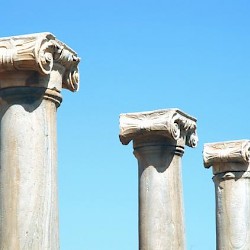 Lepcis Magna, Byzantine Church, capitals |
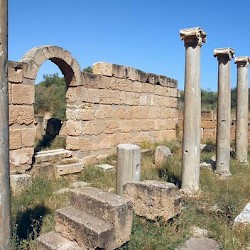 Lepcis Magna, Byzantine Church, Pulpit |
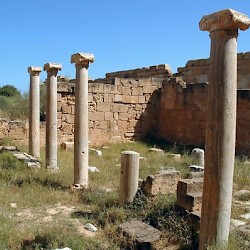 Lepcis Magna, Byzantine Church, Nave |
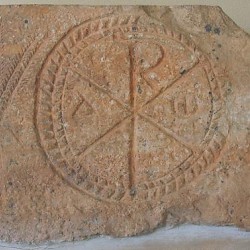 Lepcis Magna, Christian tombstone |